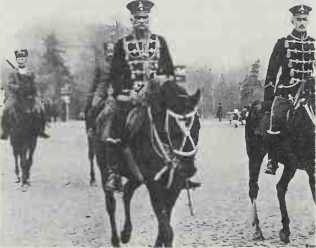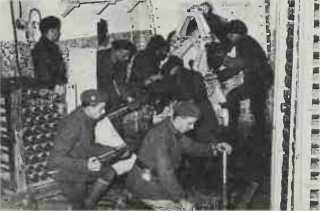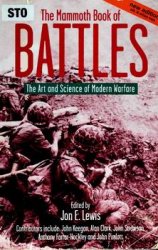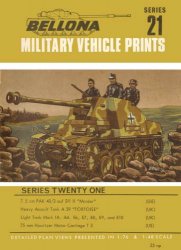Machine Gun Corps Formed in October 1915 to enable 'ickers guns to be concentrated for better tactical handling, and to make training more systematic, the Machine Gun Corps initially consisted of infantry machine gun companies, cavalry machine gun squadrons and motor machine gun batteries. The Heavy Branch, formed in November 1916, became the Tank Corps in July 1917. In 1918 machine gun battalions were organized by grouping together three or four companies of 16 Vickers guns each. The Corps was disbanded in 1922.
Mackay, Maj Gen Sir Iven (18821966). Australian. As Commander 6th Australian Division, 1940-41, took Bardia, Tobruk and Benghazi during the first British Western Desert offensive, and then took part in the Greek campaign: Commander Home Forces, Australia,
1941-42; Commander Australian forces in New Guinea, 1943.
Mackensen, Field Marshal August von (1849-19451. Ger. Mackensen served in the 2nd Life Hussar Regiment during the war of 1870-71, was assigned to the General Staff in 1880 and was later appointed as an aide de camp to Kaiser William 11. In 1908 he took over the German XVll Corps, which he was still commanding at the outbreak of war in 1914. Fighting on the Eastern Front, XVII Corps engaged the Russian III Corps at Gumbinnen on August 20, being forced to retire with heavy casualties, but recovered to play an important role at Tannen-berg, where Mackensen delivered a telling blow against the right of the Russian Second Army. In September, XVII Corps was in action against Rennenkampfs First Army at the Battle of the Masurian Lakes, then switched to Silesia to take part in the drive on Warsaw. When this was checked and the German command on the Eastern Front was reorganized, Mackensen was appointed, in November, to lead the Ninth Army, with which he recaptured Lodz on December 6. In the spring of 1915 he was placed at the head of the Eleventh Army which, as the. spearhead of the Austro-German offensive in Galicia, won a major victory at Gorlice-Tarnow

Field Marshal August von Mackensen
On May 2-3 and took Przemysl and Lemberg in June, during the subsequent pursuit. These triumphs earned Mackensen promotion to Field Marshal and, in July 1915, he was given command of an Army Group. He captured Brest-Litovsk on August 26 but, soon afterwards, was made commander of another new Army Group - containing German, Austrian and Bulgarian formations - for the offensive which overran Serbia in October and November. The following year Mackensen led the combined southern Army Group w'hich helped inflict the crushing defeat on Romania and, on December 7 1916, he entered Bucharest. Mackensen commanded the army of occupation here until the end of the war. PJS.
Mackensen, Gen Eberhard
Von (1889-1969). Ger. The son of
' August von Mackensen, he commanded III Panzer Corps, spearheading the attack on Rostov, November 1941. In autumn 1943, he handed over First Panzer Army to Hube and transferred from the East Front to Italy. Following the Allied landings at Anzio, January 1944, he took command of Fourteenth Army, hastily improvised to contain the beachhead. Taking advantage of Lucas’s initial tardiness in advancing, he launched fierce counteroffensives in February and succeeded in preventing an Allied breakout until late May. Postwar, he received a life sentence for having hostages shot, but was freed in 1952. RO’N.
Maclean, Donald Duart (191383). Br. Became communist at .; joined diplomatic service; spied for Comintern until 1951, when fled to Moscow.
Maclean, Brig Fitzroy (b. l911). Br. Parachuted into occupied Yugoslavia in September 1943 as head of a military mission to Tito. Advised that British support be devoted to the partisans rather than to Mihailovich’s Chetniks.
McMahon Line. British demarcation of Burma'China frontier, 1913, repudiated by China. Scene of constant fighting. Superseded by Burma-China treaty, 1960.
McNamara, Robert S (b. l916). US. Secretary of Defense from 1961, McNamara became President Kennedy’s most influential adviser on the Vietnam War. In August 1964 he persuaded Congress to approve the Tonkin Gulf Resolution. He subsequently lobbied Congress to support the bombing of North Vietnam and the build-up of US ground forces in the South. Continuing as Secretary of Defense under Lyndon Johnson, McNamara came to doubt the war could be won at acceptable cost. He also questioned the effectiveness of the bombing, was appalled at the killing of civilians, and found himself opposed to the Joint Chiefs of Staff. In November 1967 he urged Johnson to cease the bombing, freeze US troop levels and turn over responsibility for ground combat to the South Vietnamese. Rebuffed, he resigned. WST.
“McNamara’s Wall”. The 25-mile (40km) barrier to block infiltration from North into South Vietnam advocated by US Secretary of Defense McNamara, successively codenamed Project Practice Nine, Project Illinois City and Project Dye Marker, was popularly known as ‘‘McNamara’s Wall”. After bitter fighting to clear a path in spring 1967, US Marines constructed test lengths studded with electronic sensors, infrared devices, barbed ware and land mines. However, the professional military were sceptical and the Marine Corps opposed it. Excessive cost, redeployments during the Tet offensive, and the loss of western Route 9 following the abandonment of Khe Sanh ended the project in 1968. WST.
MAC Ship (Merchant Aircraft Carrier Ship). Improvised from merchant ships with long deck capacities, e. g. oil tankers, in World Warn.
Madagascar, British invasion of
(May 5-November 6 1942). To pre-empt Japanese use of the island, which was held by the Vichy French, a British landing force, consisting of Adm Syfret’s Force H from Gibraltar and 5th Division from England, was assembled at Durban in April. The landings on May 5 were opposed, but Diego Suarez, the northern naval base required for operations against the Japanese, fell on May 7. The rest of the island was not occupied until early November due to continued Vichy resistance.
Madras, bombardment of
(September 22 1914). Night raid by German light cruiser Emden, which closed to within 2,500yd (2,250m) of the Indian port, illuminated it with searchlights, and fired 125 4.1in shells into its oil storage tanks.
Madrid, defence of (November 1936-January 1937), Spanish
Civil War. Franco’s colonial troops reached the western edge of Madrid on November 7. The attack of November 8 was fought off in an action psychologically vital to Republican morale. Although numerically superior (40,000 to 20,000) it was a considerable feat for untrained and badly armed volunteers. That afternoon, XI International Brigade arrived, and with Russian fighters overhead, the madrilenos believed international solidarity would triumph. They endured a renewed attack via the university, the first intensive bombing of a capital and then a semi-siege which lasted to the end of the war. Franco, overconfident of victory, launched one offensive after another around Madrid. In December 1936 and January 1937 he attacked the Corunna road, then tried to surround the city from the east at the Jarama and Guadalajara. AB.
Mafeking, siege and relief of
(October 13 1899-May 17 1900), Second Boer War. Mafeking, Cape Province, was besieged by 5,000 Boers under Cronje (reduced to
2,000 men under Assistant Commandant-General Snyman from November 18), and defended by cT,100 colonial troops, militia and armed Bantu under Col Robert Baden-Powell. The latter had been ordered to raise mounted infantry to patrol the Bechuanaland border: his unthinking creation of a garrison was the main reason for the investment of a town of little military significance.
The half-hearted siege was interrupted by frequent truces. The only determined assault was made on the night of May 11-12 by 300 burghers under Commandant Sarel Eloff: the Boers penetrated the defences but were forced to withdraw (74 captured) when Snyman failed to support them. Total Boer casualties during the 217-day siege were around 800; the defenders had 273 casualties, and of the population of 1,074 Europeans and
7,500 Bantu, 4 Europeans and 329 Bantu were killed. Largely because of Baden-Powell’s flair for publicity, the siege captured the avid attention of the British public. Near-hysterical celebrations followed the news of Mafeking’s relief by a cavalry column under Col Bryan Mahon. RO’N.
“MAGIC”. American intelligence operation based on the decryption of Japanese codes before and during World War II. Col William Friedman (1891—1969) led a US Army team that broke the Imperial Japanese Navy’s “Purple” code, used up to the highest diplomatic levels, in September 1940. Although the intercepts of 1941 failed, for various reasons, to warn of the Pearl Harbor attack, “Magic” made a vital contribution to the US victories at Midway and elsewhere in the Pacific.

A magazine within the Maginot Line
Maginot Line. The subject of much unjust vilification. It was never intended to provide France with an impregnable barrier from Switzerland to the sea, but more modestly to deter Germany from attacking across the Rhine or through Lorraine. The Franco-German frontier comprised two sectors standing almost at right angles: the first running along the Rhine between Basel and Lauterbourg (110 miles' 176km); the second from Lauterbourg to Longwy on the Belgium-Luxembourg frontier (115 miles/ 184km). It was in Lorraine that the formidable Maginot defences were most fully developed. This left more than 200 miles (320km) of France’s eastern border from Dunkirk, along the Franco-Belgian frontier to the Rhine, largely unfortified. It was intended to tempt Germany into a trap to repeat her mistake of 1914.
By 1936 some seven billion francs had been invested in building the Maginot Line: more than
15.000 labourers and engineers were employed in moving
15.700.000 cu yd (12,000,000 cu m) of earth and replacing it with
2.616.000 cu yd (2,000,000 cu m) of cement and 50,000 tons of steel plate. Beneath the virtually impregnable crust there lay a subterranean world of galleries protected alike from poison gas and the leak of fumes from the gun chambers. Communications with the outside world were secured by telephone lines embedded in concrete linked with exchanges 150ft (45m) below ground. Above ground there were dense anti-tank obstacles and fire zones.
Was this whole remarkable feat of military engineering a colossal waste of money and materials? The answer must be negative: though costly, it fulfilled its main purpose of forcing the enemy to funnel his offensive through Holland and Belgium. Moreover, the Maginot Line did prove impregnable to frontal attack and was only taken from the rear in the last days of French resistance. BB.
Magnetic mine. Operated by metallic ship’s hull, causing changes in local magnetic field. The British used a magnetic mine in 1918; the Germans produced one in 1939. The answer was to “degauss” or “wipe” a ship to reduce the magnetic signature and to sweep mines by electrical pulses. The battle between increasingly sensitive mines and sophisticated countermeasures has continued.




 World History
World History



![Road to Huertgen Forest In Hell [Illustrated Edition]](/uploads/posts/2015-05/1432477693_1428700369_00344902_medium.jpeg)





